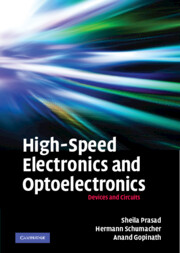4 - Optoelectronics
from Part One - Devices
Published online by Cambridge University Press: 05 August 2012
Summary
Executive summary
All land line communication systems currently use optical fibres as the channel due to their very low attenuation, and deployed systems operate up to 40 Gigabits per second (Gbps), with experimental systems at 160 Gbps and higher. These high speed systems use very stable sources, usually the distributed feedback lasers, with external modulators and very fast detectors. Direct modulation of lasers leads to chirp, caused by the laser frequency varying when modulated, and therefore is not used in these systems. However, interest remains in high speed lasers for several other applications. This chapter discusses high speed optoelectronic devices which include light-emitting diodes (LEDs), semiconductor lasers, photoconductors, p–i–n diode photodetectors, avalanche photodetectors, metal–semiconductor–metal photodetectors, travelling wave photodetectors and briefly the phototransistor. The physics of the devices are outlined and then the parameters that make these devices fast are discussed with specific examples from the literature.
Optical sources
Two types of sources are widely used in optical communication systems, and they are the LED and the semiconductor laser. LEDs are inherently slow; their response times are determined by the lifetime of the carriers in the active region, and in most LEDs this is between 2 ns and 10 ns. Thus, small-signal response of LEDs is of the order of 100 MHz, and the large-signal response is smaller than this. Lasers are complex devices, and the response time is determined by the so-called relaxation oscillation frequency, and this is due to the interaction between the photons which have a finite lifetime, which is a measure of the cavity quality factor, Q, the differential gain of the structure, the lifetime of the carriers and other parameters [1].
Information
- Type
- Chapter
- Information
- High-Speed Electronics and OptoelectronicsDevices and Circuits, pp. 221 - 288Publisher: Cambridge University PressPrint publication year: 2009
